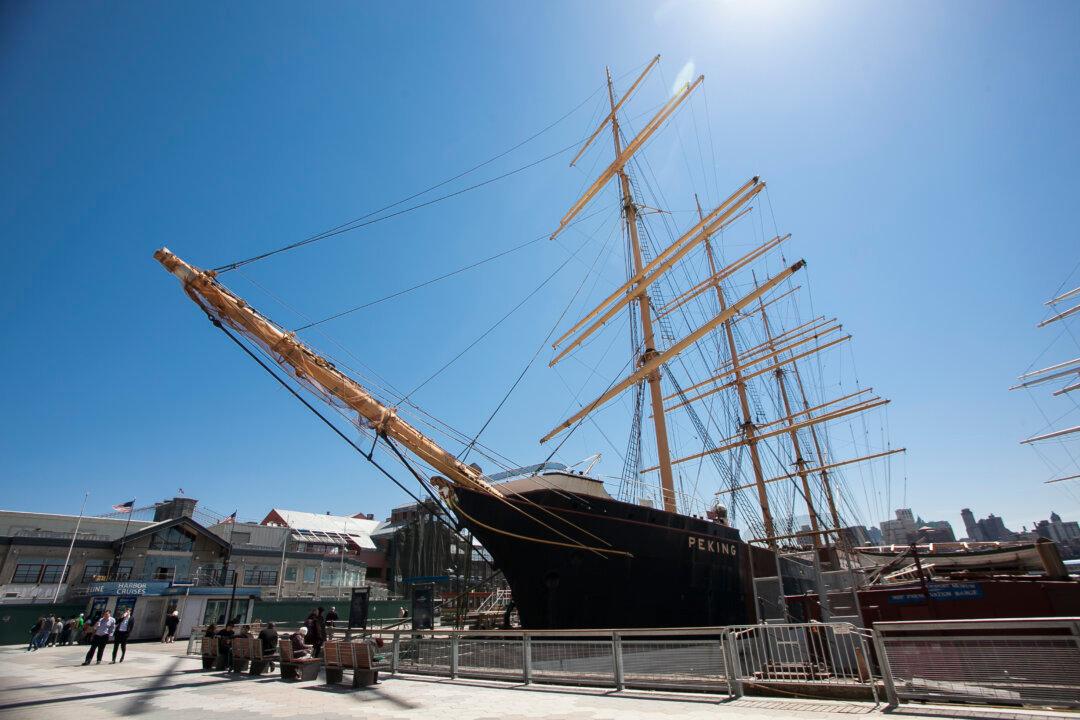NEW YORK—After a long winter of controversy over development plans, New York City’s historic maritime district, South Street Seaport, will have a neighborhood party Saturday. The South Street Seaport Museum will host a six-hour Spring Revival Festival to launch its 2014 season—with visits aboard antique ships, educational programming, live music, vendors, and local politicians.
It’s a happy moment after an intense year that saw protests from many community stakeholders over the proposed construction of a high-rise mixed-use tower at the foot of the Seaport, which is the city’s last remaining piece of 19th-century waterfront. The debate became so heated that in early 2014, the Seaport Working Group was created by the New York Economic Development Corporation to obtain consensus from important stakeholders.
The developer at the center of the controversy, the Howard Hughes Corporation, is currently demolishing the shopping mall on Pier 17 to build a new high end retail and entertainment complex.
The construction work has had little impact on the museum’s ships at the pier next door.
“The Seaport Museum has finally bounced back from Sandy and is looking forward to 2014 as the next chapter,” said Capt. Jonathan Boulware, Seaport Museum interim president on Thursday from the deck of the lightship Ambrose. He added that what makes his work at the seaport so special is its unique connection to history.
“In a city as large and complicated as New York, we have the privilege to work in a piece of its fundamental origins,” he said. “The story of the South Street Seaport is the first chapter in the story of the city of New York.”
For Boulware, the seaport’s enduring popularity with tourists is part of what will continue to keep it alive and thriving, but the long-term viability will also depend on New Yorkers. The museum, which was founded in 1967, is doing what it can to preserve the area’s cultural and historical treasures.
Seaport Museum holdings are spread through a 12 square-block historic district on the East River in Lower Manhattan, at the site of the original port of New York City. The museum’s main building and exhibits have no working elevators or escalators due to millions in damage from Sandy, but the building is open for scheduled educational tours and prearranged visits.
Other holdings include the ships and a traditional print shop, Bowne Printers, and Bowne & Co. Stationers, the oldest existing business in New York City, founded in 1775.
On Saturday, the ships at Pier 16 in Manhattan will raise their sails. There will be ticketed guided tours, and Manhattan Borough President Gale Brewer will ring the bell of the Ambrose to signal the start of the season. After that the ships will be open for the remainder of the spring and summer.
The Ships of South Street Seaport
The Ships of South Street Seaport
There are six ships that are part of the South Street Seaport Museum, all of them docked in Manhattan at Pier 16. Tickets can be purchased to climb aboard the ships and get a tour, or take a sail around New York Harbor.
Ambrose
Built in 1907, it’s what’s known as a “floating lighthouse.” It was used to guide ships from the Atlantic Ocean into the lower New York Bay between Coney Island, New York, and Sandy Hook, N.J., for decades. It was given to the museum in 1968 by the U.S. Coast Guard.
Lettie G. Howard
One of few surviving examples of the fishing schooners once widely used in the North Atlantic. In 1994, it went through an extensive two-year rebuild to be restored to its original appearance. It was first put in the water in Essex, Massachusetts, in 1893.
Pioneer
Built as a sloop in Marcus Hook, Pa., in 1885, she carried mined sand; the Pioneer was re-rigged as a schooner at just 10 years old. It regularly sails the waters of New York City with tourists, private charters, school groups, and birthday parties.
W.O. Decker
A wooden tugboat built in Long Island City, Queens, in 1930, it was one of the last steam-powered tugs built in New York Harbor. The boat uses its refitted diesel engine to help tug the museum’s fleet. It is also used for private charters of up to six passengers.
Wavertree
Built in Southampton, England in 1885, the Wavertree was one of the last large sailing ships built of wrought iron and is the largest still afloat today. It is currently undergoing planned restoration work and is not open to the public.
Peking
Constructed in Hamburg, Germany in 1911, the Peking is a massive four-masted barque and one of the famed Flying P Liners of F. Laeisz Lines. Peking starred on the silver screen in the Irving Johnson film “Around Cape Horn” that documented her 1929 passage around the southern tip of South America in hurricane conditions. Tickets can be purchased to go aboard the Peking Wednesdays through Sundays from 11:00 a.m. to 5:00 p.m.




